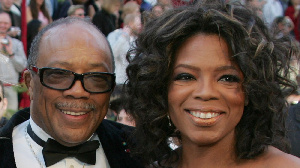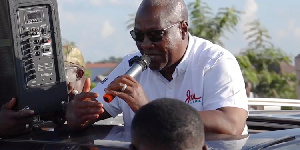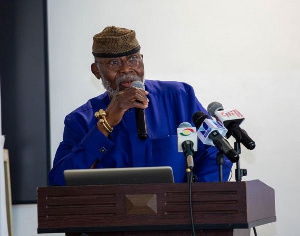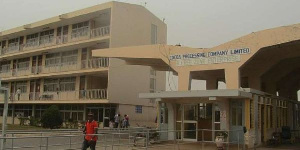Opinions of Wednesday, 23 February 2005
Columnist: Fredua-Kwarteng, Y.
Ghana Flunks Math and Science: Analysis (2)
This is the last part of our two-part analysis of Ghana?s poor performance in TIMSS (Trend in International Mathematics and Science Study) grade eight mathematics and science tests. The first part analysis focused on the TIMSS mathematics for grade eight, which Ghana performed so badly that it ended in the 44th position among 45 countries that participated in the test. In terms of the scores, Ghana?s eighth graders obtained an average of 276 in mathematics compared to the international average of 466. In the science test, Ghana?s grade eight students scored 255 points exceedingly below the international average of 473 points. By comparing the two scores, it is obvious that Ghana?s eighth graders performed better in the mathematics test (21 points more) than they did in the science test.
In junior secondary schools in Ghana, students are not taught to view science as a form of knowledge concerned with understanding natural phenomena, leading to both knowledge validation and construction. In other words, the objectives of science instruction at all levels should be inquiry and construction of knowledge based on both the physical and biological environment. Given these objectives, the starting point for science education is for students to ask questions about their environment and try to figure out answers to these questions. The following questions on the TIMSS science test for grade eight explicitly exemplify what we mean by focusing science instruction on observation of students? environments?both physical and biological environments.
1. The moon produces no light, and yet it shines at night. Why is this?
A) The moon reflects the light from the sun.
B) The moon rotates at a very high speed.
C) The moon is covered with a thin layer of ice.
D) The moon has many craters.
2. Paint applied to an iron surface prevents the iron from rusting. Which one of the following provides the best reason?
A) It prevents nitrogen from coming in contact with the iron.
B) It reacts chemically with the iron.
C) It prevents carbon dioxide from coming in contact with the iron.
D) It prevents oxygen and moisture from coming in contact with the iron.
3. Which statement best explains why mammals are found in very cold regions of the world, but lizards are not?
A) Both mammals and lizards are cold-blooded, but mammals have fur to keep them warm.
B) Both mammals and lizards are warm-blooded, but lizards get too cold when they shed their skin.
C) Since mammals, but not lizards are warm-blooded, their body temperature will adjust to match the external temperature.
D) Since mammals, but not lizards, are warm-blooded, they will maintain their body temperature using heat from the metabolic process.
4. What feature is shared by all insects?
A) External skeleton B) Two pairs of wings C) Jumping legs D) Stinging mechanism.
5. Most of the energy released when gasoline burns in a car engine is not used to move the car, but is changed into
A) Electricity B) Heat C) Magnetism D) Sound
6. Immediately before and after running a 50 meter race, your pulse and breathing rates are taken. What changes would you expect to find?
A) No change in pulse but decrease in breathing rate.
B) An increase in pulse but no change in breathing rate.
C) An increase in pulse and breathing rate.
D) No change either.
All the six questions above have one common thread running through them ? they are based on the physical and biological environment. Students who observe these environments carefully and ask questions are more likely to answer these questions correctly than students who learn solely from science textbooks or resources. For questions 1, 2, 4, and 5 students who are preoccupied with understanding their physical and biological environments would hardly get them wrong. Except that students with limited English comprehension skills, which most of the students in grade 8 (or JJS 2) in Ghana have, would have difficulties answering those questions correctly. Barring that a primary five student in Ghana should be able to explain that after running both the pulse and breathing rates increase simultaneously. For question 5, most Ghanaian students are more likely to have a difficulty with the word ?gasoline?, which is an American than British. As Ghanaian students learn the British variety of English, they are more used to the word ?petrol?. However, the words ?car and burn? in the question might signal to the student that the word gasoline and petrol may be synonymous. It should also be considered that not many students at that level would have seen a car engine before. A part from these difficulties, Ghanaian eighth graders are most likely to understand that petrol used in a car is converted into mechanical energy and heat energy.
For question 2, we should assume that all grade eight students in Ghana have seen people painting the surface of an iron before. Because the reference point for science instruction at the eighth grade level is not about inquiry and construction of knowledge many students may not have wondered why the painting is necessary. Question 3 seems a little tricky, but it should not be. In Ghana, most children have seen lizards around their physical environment. And when the sun starts scorching lizards run and hide under rocks, stones or abandoned buildings where the temperature is cool. A desire to understand this simple observation will lead to the fact that lizards are cold-blooded animals. A further inquiry may lead to the knowledge that other mammals in cold areas of the world such as caribou, deer, rabbit, and fox are warm-blooded; they are able to maintain their body temperature by using heat generated from the metabolic process in their bodies. In most public elementary schools across Ghana science is not taught at all either as an integrated subject or stand-alone subject. The most common excuse is not lack of expertise rather lack of resources science education such as textbooks and laboratory materials and equipment. It is argued that the lack of these resources has a demoralizing effect on teachers to teach science. The critics may also argue that with a teacher salary that barely feeds her for the month, why should she strain herself to teach science? Nonetheless, from our professional judgement, primary school science does not require textbooks or laboratory. Science reference books for teachers and inexpensive equipment such as hand-held magnifier/microscope, scale balance, and charcoal pot would be sufficient for teaching and learning science at that level.
Our investigation also indicates that in some private international/preparatory schools in Ghana attempts are made to teach science and in some public elementary schools teachers beat the odds and teach science once a week. At the junior secondary school level (JSS), all the students in JSS 3 are required to pass general science in their Basic Education Certificate Examination (BECE) before they are admitted to senior secondary school. Therefore, teachers at that level teach basic science concepts, scientific terms and facts, and to a limited extent science process/inquiry skills. The teaching methodology usually consists of straight lectures or direct-teaching, which requires the students to listen attentively throughout the duration of the instruction. After the lectures, students are required to complete exercises that demand regurgitation of the facts gleaned from the lectures. Occasionally, students do hands-on learning activities or investigations with the students much more likely to follow specific instructions in completing an activity or investigation than designing or implementing their own investigations. Usually, such activities or investigations are not about what students can observe in their environment and the point of reference of those learning activities are culturally and environmentally distant to the students. Hence, students? interest is not stimulated to enjoy science as a form of knowledge construction but only at best as a validation of some ?divine? knowledge. The ultimate result is that, science learning in the JSS is reduced to rote learning and memorization of facts.
In our first analysis on the TIMSS mathematics for eighth graders, we cited language as one of the contributory factors to the dismal performance of Ghanaian students on the mathematics test. Since Ghanaian students wrote both the mathematics and science tests in English, they were most likely to experience some difficulties comprehending the questions. The science test even involves more ?languaging? than the mathematics test involves, in that most of the questions are longer and require students to read carefully, understand what is required, and then decide the appropriate response. The TIMSS science test question for grade eight below requires more language comprehension: Alexander Fleming noticed that bacteria growing on a plate of agar did not grow next to a mold that was growing on the same plate. He wrote in his laboratory report: ?The mold may be producing a substance that kills bacteria.? This statement is described as
A) An observation B) A hypothesis C) A generalization D) A conclusion
An eighth grader whose first language is non-English, as Ghanaian students are, must understand the scientific meanings of observation, hypothesis, generalization, and conclusion before she/he can answer this question correctly. Though these scientific terms are integral components of the scientific method used in laboratory reporting, most Ghanaian eighth graders are most likely to struggle between observation and hypothesis as the appropriate response to the question. However, is it important if the student is unable to choose hypothesis as the most suitable response? In our opinion, a Ghanaian student who has a limited science vocabulary may answer this question inappropriately but may have observed and investigated many scientific causes of such phenomenon. Yet his or her ability to answer that question satisfactorily requires a good stock of science vocabulary in English. Consequently, our conclusion is that Ghanaian students? performance on the TIMSS science test cannot be used as a measure of their scientific aptitude. Nevertheless, this conclusion does not imply that we do not have to find ways to improve science teaching and learning in our schools.
The improvement of science teaching and learning at the primary, junior and senior secondary levels requires that the Ghanaian physical and biological environments must be the entry point to science instruction. This pedagogic strategy has many advantages. First, it compels young people to begin to ask both simple and critical questions about things that they observe in those environments. Second, knowledgeable elders in our society would be an invaluable source of scientific knowledge for young people to tap. This is because through careful observations of the environments these elders have formulated hypotheses, tested them, and have constructed knowledge which can be generalized across a fair number of cases. For example, students may ask, what are the effects of using warm/hot water to massage a person with sore, swell, twisted or broken bone? What soil types are suitable for the cultivation of tomato? Is the soil suitable for tomato cultivation also suitable for pepper, okro or garden eggs cultivation? How can we decrease the gestation period of cassava from three months to one month? What are the properties of leaves that are able to cease blood from oozing from a cut? What are the cardiovascular benefits of drinking coconut water? What causes fruits to ripe? Why is it that most traditional medicines have the purpose of cleansing the bowel/colon, liver, kidneys, and lungs? What is the relationship between pathogen and cleansing of these organs? Certainly, our knowledgeable elders could help young people to find answers to these questions and many others. In that case, our?traditional? scientific knowledge would have its appropriate place in our schools and science teachers and textbooks would no longer be the exclusive sources of scientific knowledge or science education.
Third, focusing science instruction on the Ghanaian environments has the potential to kick start a technological revolution in Ghana. For example, the knowledge that students gained from the causes of fruit ripening could be used to speed up fruit ripening for local or international market. Also the knowledge student obtained from the relationship between pathogen and bowel/colon cleansing would help them to understand disease causation in the human body, diagnosis and treatment. Technology as we understand it entails the application of scientific knowledge to develop tools or solve problems. We have more than a dozen problems in every sector of our national life that needs immediate solutions in our effort to build a prosperous nation-state. In fact, we envision a science education that acquaints our youth with these problems and as they mature in their knowledge they are likely to develop solutions for these problems.
The improvement of science education in basic and secondary schools also requires a teacher-preparation program that emphasizes scientific inquiry and knowledge construction as the fundamental goals of science education in Ghana. Scientific inquiry entails conscious observation and measurement, experimentation, exploration and analysis. In teaching scientific inquiry, we are strongly in favour of helping students to develop a repertoire of inquiry skills, so that they would be able to design their own experiments and carry them rather than always doing those suggested by the teachers or textbooks. Inquiry would provide students the necessary empirical data to construct knowledge to explain natural phenomena. As a matter of fact, some of our elders are able to construct knowledge to explain their social, physical, and biological worlds. They used their observations to construct knowledge to build social institutions, engage in farming and even codify laws that govern social and economic relations before the advent of British colonialism. Nevertheless, our current colonial education system socializes students to be mere consumers of knowledge produced in Euro-America rather than constructors of knowledge. Accordingly, an educated person in Ghana is usually is one who is able to regurgitate knowledge constructed in Euro-Americans and not one who is able to construct knowledge to solve his or her personal problems, community or national problems. This form of science education in Ghana only reproduces and reinforces our economic and technological underdevelopment.
Allied to inquiry and knowledge construction is pedagogy. Every science teacher must have a clear idea why she or he is teaching science in general and specifically a particular scientific concept and why students have to learn it. Teaching a scientific concept as mandated by Ghana Education Services and which students are required to learn whether they like it or not is not good enough. Nor is it good enough to teach students scientific concepts in order to prepare them for university-based degrees or other tertiary institution programs. We are not implying that it is insignificant or useless to prepare students to enroll in science or technology programs at the university level. On the contrary, preparing students for merely university degree programs tends to elitize science as a knowledge form belonging to the citizens of the Ivory Towers and that ordinary folks do not have any use for scientific knowledge. We do not need to recount here that those who have contributed to human stock of technological knowledge are ordinary folks with basic knowledge of science and a high level of creativity. Considering the multiplicity of problems that Ghana is facing, the most appropriate science pedagogy must be knowledge construction for problem-solving and problem-posing. After all science pedagogy must never be fixed and it should be constructed in accordance with the exigencies of our circumstances. We would also like to add that a teacher?s pedagogy informs and influences his or her selection of teaching methodology or strategies. We are very much concerned about how we can help to create and sustain a scientific culture in Ghana via our conventional schooling system. It is a form of educational reconstructionism; therefore, the teaching and learning of science at the primary level is crucially important to the creation of that culture. For this reason, we recommend a mandatory professional development program in science education for primary school teachers, in order to prepare them to teach science effectively. We also urge the government to show leadership by formulating a national science policy through a deliberative, democratic dialogue with stakeholders of our educational enterprise (teachers, teacher educators, professors, educational administrators, business leaders, elders, students, community leaders, and ordinary citizens). A national science policy should go beyond establishing ten science learning centres across the country as the government did in the past. A national science policy, among other things, should also establish achievable objectives and outcomes for basic schooling, senior secondary schooling, and tertiary institutions. The reference point for science education is our natural environments. Such a policy should put in place periodic training schemes for science teachers to incorporate innovative teaching practices and provide a link between science teachers at different levels of the educational system. It also establishes practical criteria for evaluating progress in science education at every level of the nation?s education system. The policy encourages and provides incentives to individuals to undertake scientific research for the solution of community or national problems.
We anticipate that when the culture of science teaching became well entrenched at the primary level, it would help to remove the myth that learning science requires students to have the brains of elephants. Primary school pupils would then engage in fruitful debates and discussions based on their observational findings, conjectures, and experiments. They would ask critical questions and subject claims to verification rather than absorbing information pushed down their throats. These kids would be attentive to and try to construct scientific knowledge about what their parents and relatives do at home and in the community such as the manufacturing of ?alata samina?, brewing of ?pito?, iron smelting/blacksmithing, and animal cross-breeding. These optimistic dreams of that form of science education at the primary level would be brought into fruition one day.
Entertainment










